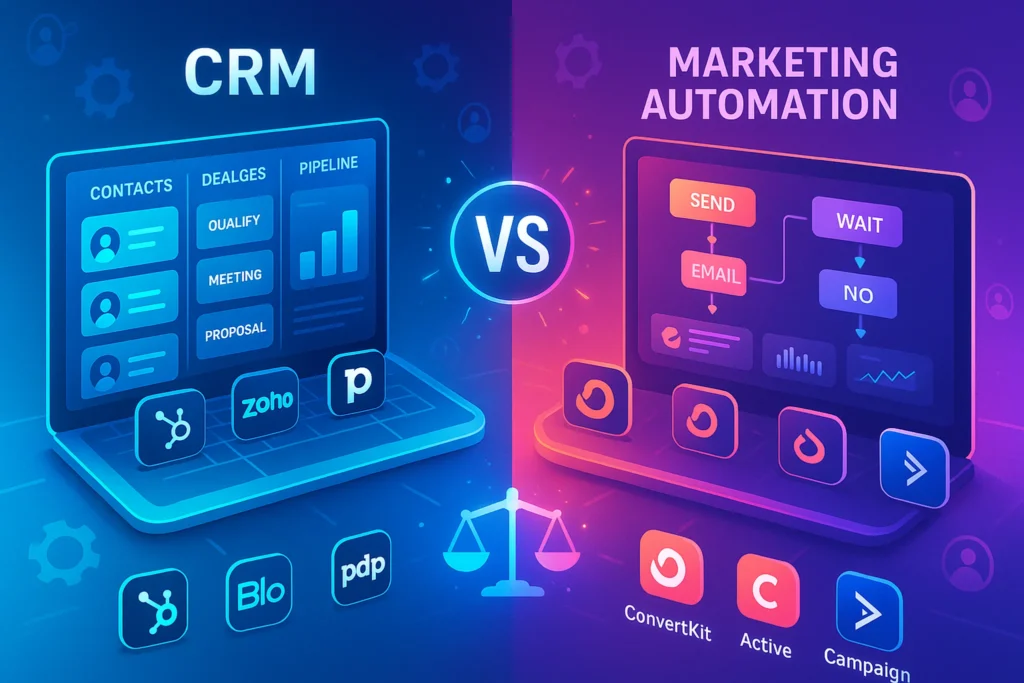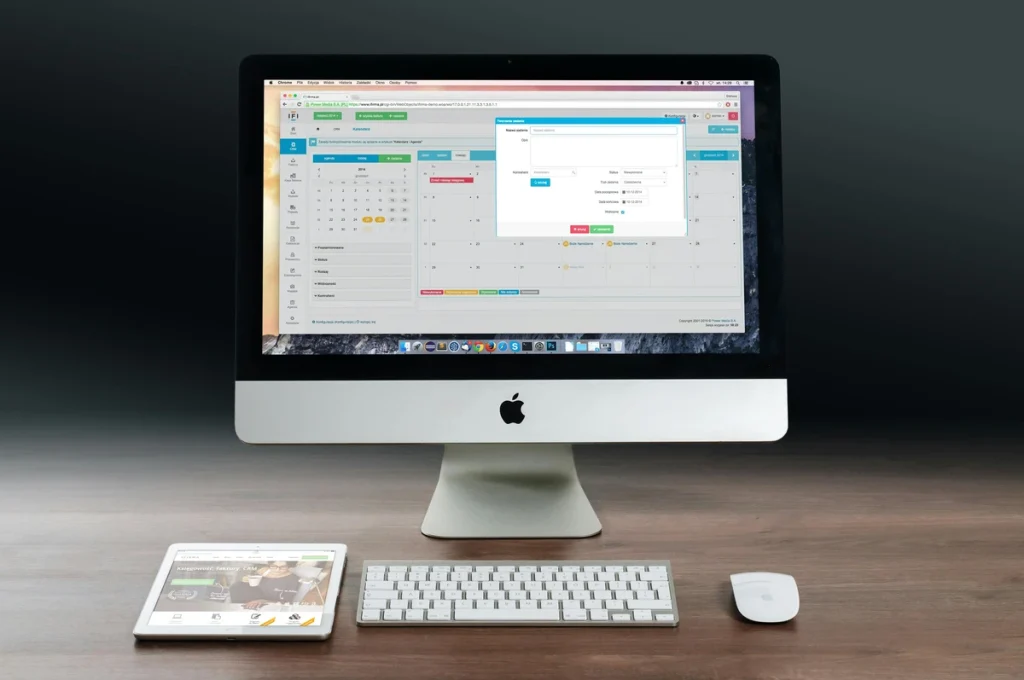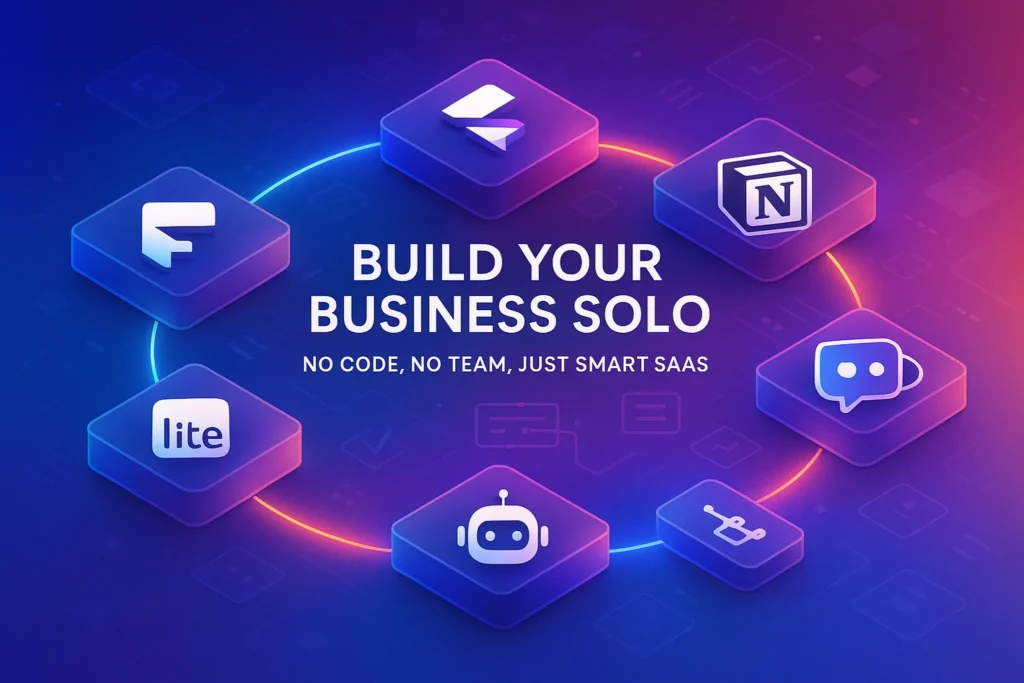-This post may contain affiliate links. If you click on one and make a purchase, I may earn a small commission at no extra cost to you.-
🌍 Intro: CRM and Marketing Automation Aren’t the Same—Here’s Why It Matters
If you’ve ever confused a CRM with Marketing Automation, you’re not alone. These terms are often tossed around interchangeably, especially in SaaS sales pages and marketing guides.
But make no mistake — they serve very different purposes.
In this post, we’ll break down:
-
What each system does (and doesn’t do)
-
Who should use which (and when)
-
The best tools for different use cases
-
And finally — how to decide which one your business needs right now
Let’s clear up the confusion, once and for all.
🧩 What is a CRM? (Customer Relationship Management)
A CRM (Customer Relationship Management) system is much more than a digital address book — it’s the strategic command center for managing every aspect of your relationship with prospects, leads, and existing customers.
Think of it as your team’s collective memory: it stores every interaction, every note from a sales call, every support ticket, and every deal in progress. Instead of sticky notes, scattered spreadsheets, or siloed inboxes, you get a centralized, organized, and searchable view of your customer pipeline.
🔍 What Does a CRM Actually Do?
-
Tracks interactions: Every call, email, or meeting is logged for visibility and context.
-
Manages pipelines: Move deals through different stages visually (e.g., “lead”, “qualified”, “proposal sent”, “won”).
-
Assigns ownership: Team members are responsible for specific contacts or deals.
-
Automates reminders and tasks: No more missed follow-ups.
-
Generates reports: Understand close rates, rep performance, and revenue forecasts.
🧠 Why It Matters
Sales is all about timing and trust. If a salesperson forgets to follow up, or if a customer has to repeat their issue twice, you lose credibility. A CRM ensures that nothing slips through the cracks, and that customer relationships scale with care — even as your team grows.
🧰 Real-World CRM Example
Let’s say you run a design agency. You receive inbound leads from your website, but struggle to track who followed up with whom. With a CRM like Pipedrive, every lead gets entered into a pipeline. You can assign it to a sales rep, set an automatic follow-up reminder, and record outcomes — all in one dashboard. Over time, your team closes more deals just by being consistent and accountable.
🌱 Scalability Benefit
As your customer base grows, a CRM doesn’t just help you stay organized — it helps you identify patterns. You can analyze:
-
Which channels bring in your best leads
-
What objections keep showing up
-
Who your highest lifetime-value customers are
That’s a strategic goldmine.
🛠️ What is Marketing Automation?
While CRM is about managing relationships, marketing automation is about engineering them.
It refers to the software and systems that allow you to deliver the right message, to the right person, at the right time — without manual effort. Whether you’re nurturing leads over email, re-engaging cold subscribers, or sending dynamic offers based on user behavior, automation lets you scale personalized marketing.
🔍 What Does It Do?
-
Email Sequences: Timed follow-up campaigns triggered by signup, purchase, or inactivity.
-
Lead Scoring: Automatically assign value to leads based on engagement (e.g., link clicks, site visits).
-
Segmentation: Group users by behavior, location, or lifecycle stage.
-
Trigger-Based Actions: If a user downloads an eBook but doesn’t sign up — send them a reminder 48 hours later.
💡 Key Difference from Email Marketing Tools
Basic email tools (like Gmail or Mailchimp Free) are manual or blast-based. Marketing automation goes several levels deeper — behavior-driven logic, event triggers, decision trees, and real-time personalization.
🧰 Real-World Marketing Automation Example
Let’s say you’re a course creator. A new lead downloads your free eBook. Your automation tool (e.g., ConvertKit) sends a welcome email. Two days later, it sends a case study. If the lead opens and clicks, they’re tagged as “engaged” and get your sales offer. If not, they enter a “re-engagement” flow instead. No manual writing. No forgetting. Just intelligent nurturing.
🚀 Benefits for Solo Marketers and Teams
-
Work 24/7 while you sleep
-
Consistency in lead nurturing
-
Higher conversion rates through personalization
-
Improved ROI on content and traffic
In short, it’s the invisible sales team working behind the scenes.
💡🧠 Still unsure which to pick?
Download our FREE checklist:
“CRM vs. Marketing Automation: What Fits Your Business?”
PDF includes: 7 questions to identify your current stage + tool matching recommendations.
✅ Not Sure What Tool You Need?
Still unsure what your business really needs? This one-page checklist helps you decide in under 3 minutes — based on your stage, goals, and sales process.
Download our exclusive checklist PDF:
- ✔️ 7 Insightful Questions
- ✔️ Clear Action Recommendation
- ✔️ Perfect for solo founders & teams
🔒 100% free. No spam. Just smart guidance for business growth.
🔄 Side-by-Side Comparison
| Feature | CRM | Marketing Automation |
|---|---|---|
| Goal | Customer management | Lead nurturing |
| Focus | Relationships & sales | Campaigns & conversions |
| Main Users | Sales, Support | Marketers, Creators, Solopreneurs |
| Popular Tools | HubSpot, Zoho, Salesforce | ActiveCampaign, ConvertKit |
| Data Type | Contact history, deals | Email flows, lead scoring |
🎯 Which One Does Your Business Need?
Picking the right one depends on where your business is in the customer journey:
The decision between CRM and marketing automation isn’t about which is better — it’s about what problem you need to solve today.
📌 Ask Yourself These Questions:
-
Are you trying to convert more leads into customers?
-
Or are you trying to manage existing customers and build long-term value?
If you’re in a service-based business, managing ongoing client relationships, proposals, contracts, and check-ins — you’ll likely benefit more from a CRM first.
If you’re running a content-driven business — like a blog, YouTube channel, or info-product — and you’re collecting emails from cold traffic, then marketing automation should be your priority.
🔍 Hybrid Reality (Most Businesses Need Both)
Here’s the catch: As your business scales, you’ll realize that CRM and marketing automation complement each other.
For example:
-
You capture a lead through your ConvertKit sequence (marketing automation)
-
The lead replies with interest → You add them to HubSpot and track the sales cycle (CRM)
-
After the sale → You continue post-purchase nurturing via email automation
This loop lets you nurture, close, and retain customers more efficiently.
⚠️ Budget Tip
Don’t try to use an “all-in-one” tool unless it truly excels at both functions. Sometimes, a combo of two focused tools (e.g., MailerLite + Zoho CRM) outperforms one bloated platform.
🔹 Choose CRM if:
-
You have returning customers
-
Your sales team interacts manually with leads
-
You track calls, meetings, and follow-ups
-
Support and human relationships matter
🔹 Choose Marketing Automation if:
-
Email marketing is your top priority
-
You have a lot of leads but few conversions
-
You want to automate nurturing and segmenting
-
You’re running funnels or info-products
🔍 Use Case Layering by Persona
| Persona | Best Pick | Why |
|---|---|---|
| Solopreneur | ConvertKit | Simplicity + email automation strength |
| SaaS Startup | HubSpot CRM + ActiveCampaign | Sales + nurturing balance |
| Coach/Creator | MailerLite | Broadcast + basic automation |
| Sales Team | Zoho CRM | CRM reporting + pipeline control |
This matrix shows that sometimes both tools work better together — but it depends on your growth stage and resources.
🔧 Best CRM & Marketing Automation Tools
Choosing between CRM and marketing automation software doesn’t have to be confusing — as long as you understand what each tool actually does for your business.
Here are six battle-tested tools, broken down by category and explained with clarity, value, and practical use.
🧰 1. HubSpot (CRM + Automation Hybrid)
Category: CRM (with optional Marketing Automation)
HubSpot is like a digital Swiss Army knife — it starts free and scales like a beast. Its core CRM is completely free and genuinely useful, especially for sales teams and small businesses. But the magic happens when you plug in its marketing automation modules.
How it helps you:
Imagine someone fills out your pricing form. Instantly:
-
HubSpot logs them in your CRM with full contact details
-
Automatically assigns them to your sales team
-
Sends a personalized email thanking them
-
Tracks whether they visit the pricing page again — and notifies your team
This isn’t marketing fluff. This is real-time, full-funnel customer journey management, from lead to close — all in one interface.
Perfect for:
SaaS startups, service providers, consultants, and teams that want sales + marketing alignment.
Why It’s Valuable:
HubSpot’s free CRM is legendary — but what most don’t realize is how powerful their marketing automation starter tier is. Ideal for small businesses and solopreneurs who want to grow into a full-stack platform.
Best For: SaaS startups, agencies, B2B service providers
Real Use Case: A small agency uses HubSpot to capture leads, automate follow-ups, and close deals — all without juggling multiple tools.
💬 2. ActiveCampaign (Marketing Automation First, CRM Optional)
Category: Marketing Automation (with optional CRM features)
ActiveCampaign isn’t just an email tool — it’s a marketing intelligence engine. If you run a business where timing, personalization, and segmentation matter (hint: that’s every business), this is your go-to platform.
How it helps you:
Let’s say someone signs up for your lead magnet. Most tools send them a generic email. ActiveCampaign? It lets you create behavior-based automation sequences. For example:
-
If they open the first email → send them Case Study A.
-
If they don’t click → wait 3 days and send a different resource.
-
If they click but don’t buy → tag them as “Interested” and score them +20 points.
You can build full automation trees that feel one-on-one — without actually doing it manually. And it scales effortlessly.
Perfect for:
Course creators, email marketers, agencies, and anyone who wants to build intelligent funnels without code.
Why It’s Valuable:
If you need smart automations — branching logic, conditional emails, scoring — this is your powerhouse. Their built-in CRM is decent, but the automation suite is where it shines.
Best For: Coaches, email marketers, funnels
Real Use Case: A course creator segments their list based on quiz answers, delivers personalized email paths, and upsells high-ticket coaching.
✉️ 3. MailerLite (Simplest All-in-One for Starters)
Category: Marketing Automation
If you’re a solo creator, small business owner, or blogger who just wants to get started quickly and beautifully, MailerLite is one of the best entry-level tools on the market.
But don’t let the clean interface fool you — this tool packs serious automation muscle.
How it helps you:
You can build custom workflows like:
-
Welcome sequence → based on form source
-
Tagging readers by interest → based on link clicks
-
Abandoned cart emails → if you’re running a Shopify or WooCommerce store
-
Delivering lead magnets → instantly and automatically
Its email builder is drag-and-drop, mobile-responsive, and lets you A/B test content. You can even build full landing pages, pop-ups, and embed forms — no extra tools needed.
Perfect for:
Bloggers, creators, newsletter owners, and small eCommerce brands.
Why It’s Valuable:
Beautiful emails, automation, landing pages, and popups — all in one clean UI. Ideal for users who are new to automation and want an easy learning curve.
Best For: Bloggers, creators, newsletters
Real Use Case: A niche site builds a lead magnet funnel with MailerLite, tags users based on interests, and promotes affiliate products via segmented campaigns.
🔄 4. Brevo (Sendinblue) — Automation with a CRM twist
Category: Marketing Automation + Lightweight CRM
Brevo offers something unique — it blends email marketing, SMS marketing, WhatsApp messaging, and a basic CRM into one unified platform. If your audience is global or multi-channel, this tool will feel like magic.
How it helps you:
Say you run a local business or an international eCom brand. With Brevo, you can:
-
Send email and SMS reminders about bookings or offers
-
Tag users based on behavior or source (email, WhatsApp, ad click)
-
Automate appointment follow-ups, discount triggers, and cart abandonment flows
-
View customer history in a built-in CRM panel
It’s ideal for small businesses that want powerful communication features without getting overwhelmed.
Perfect for:
eCommerce, coaches, multilingual brands, and local businesses.
Why It’s Valuable:
Brevo blends simple CRM + email marketing + SMS + WhatsApp into one. Great for eCommerce and local businesses who want to go beyond just email.
Best For: Local businesses, multilingual lists, Shopify stores
Real Use Case: A Shopify brand builds automation for abandoned carts + re-engagement via email & SMS in Brevo — all from one dashboard.
💼 5. Pipedrive (Sales-Driven CRM)
Category: CRM
Pipedrive is a sales-focused CRM, built by salespeople, for salespeople. It’s designed to help teams close deals faster — not get bogged down by unnecessary features.
How it helps you:
Picture this: You’re an agency owner managing 20+ leads at various stages. With Pipedrive, you see every deal in a visual pipeline — who you’ve contacted, who’s waiting for a proposal, and who needs follow-up.
The best part? You can:
-
Set automatic reminders and tasks for each deal
-
Track email opens and calls
-
Get clear reports on who’s performing and what’s converting
It’s clean, fast, and focused purely on closing deals.
Perfect for:
Sales teams, consultants, service agencies, and anyone with a high-touch sales process.
Why It’s Valuable:
One of the easiest sales-focused CRMs out there. No fluff, just pipelines, forecasting, and automation that actually help sales teams close deals.
Best For: Sales teams, consultants, agencies
Real Use Case: A consultancy uses Pipedrive to track inbound leads, set task reminders, and automatically move deals across pipeline stages.
🧠 Bonus Tool: ConvertKit (For Creators + Email-First Businesses)
Category: Marketing Automation
Built by creators, for creators, ConvertKit is the email marketing platform that helps you grow and monetize an audience — without tech overwhelm.
It ditches clunky menus in favor of simple, visual automations that just work. Yet it’s powerful enough to segment audiences by behavior and deliver perfectly timed content.
How it helps you:
Say you run a niche newsletter. You offer a free checklist. When someone downloads it:
-
ConvertKit tags them based on the topic
-
They enter a tailored welcome series
-
If they click “Case Study” emails → they’re funneled into a paid offer
-
If they go cold → they move into a reactivation sequence
You can even create multiple opt-ins with different entry paths — perfect for niche audiences.
Perfect for:
Writers, coaches, solo business owners, podcasters, and creators of all kinds.
Why It’s Valuable:
ConvertKit shines for content creators — YouTubers, podcasters, writers. Clean email builder, flexible tags, and landing pages baked in.
Best For: Solo creators, newsletters, product launches
Real Use Case: A writer builds a welcome series, tags users by interest (e.g., fiction vs. copywriting), and nurtures each with personalized offers.
✅ Pro Conversion Tip
🎯 Instead of pushing all tools equally, match the tool to your reader’s persona.
| Persona | Recommended Tool | Why |
|---|---|---|
| Blogger | MailerLite | Easy landing pages + automation |
| SaaS Startup | HubSpot + Pipedrive | Lead capture + sales tracking |
| Course Creator | ConvertKit | Deep email logic + creator-focused tools |
| Digital Agency | ActiveCampaign | Logic-based automation + lead scoring |
| Local Biz | Brevo | Multichannel + transactional focus |
🧠 Nerd Verdict
The truth is: most growing businesses will eventually need both.
But when you’re starting out, it’s smarter (and more budget-friendly) to pick one.
So the real question is:
Are you managing customers or nurturing leads?
Let that answer guide your tool choice.
❓ FAQ: Nerds Ask, We Answer
💬 Would You Bite?
You’ve got the budget for just one tool:
CRM or Marketing Automation?
Drop your thoughts or questions in the comments — let’s help each other decide smarter. 👇



